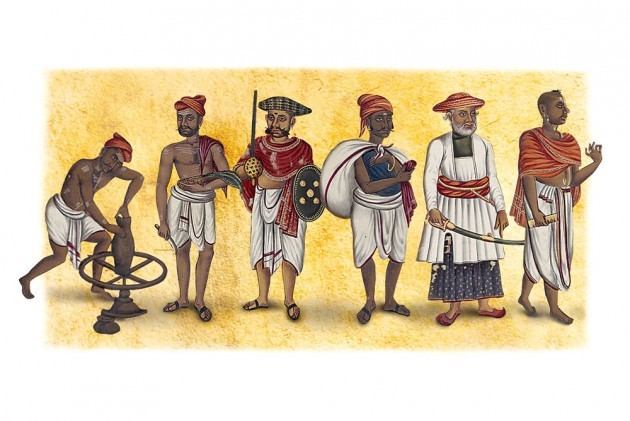
The Invisible History of Slavery in Kerala – A Book Review
Author: Naveen Prasad Alex
 There are many areas that have been largely untouched by mainstream historiography for ages. The recent historical studies about slavery in Kerala are revealing unknown facts and hidden historic facts. This historical task was first undertaken by P Sanal Mohan’s book ‘Modernity of Slavery: Struggles against Caste Inequality in Colonial Kerala’. Those studies are being developed and continued through Vinil Paul’s Malayalam book ‘The Invisible History of Slave Kerala’. Vinil Paul mentions in the book that the discussion about slavery Kerala did not develop. “The number of research papers looking at separated slaves from Kerala was less than studies elsewhere in India”. Especially topics like slavery and slave trade have never been a topic of discussion in the Kerala historiography.
There are many areas that have been largely untouched by mainstream historiography for ages. The recent historical studies about slavery in Kerala are revealing unknown facts and hidden historic facts. This historical task was first undertaken by P Sanal Mohan’s book ‘Modernity of Slavery: Struggles against Caste Inequality in Colonial Kerala’. Those studies are being developed and continued through Vinil Paul’s Malayalam book ‘The Invisible History of Slave Kerala’. Vinil Paul mentions in the book that the discussion about slavery Kerala did not develop. “The number of research papers looking at separated slaves from Kerala was less than studies elsewhere in India”. Especially topics like slavery and slave trade have never been a topic of discussion in the Kerala historiography.
The ‘Invisible History of Slave Kerala’ becomes relevant here. Vinil Paul makes a comprehensive study using diaries, letters, court documents and commercial litigation notes as supporting material. The author presents his findings in a very simple language. It is a very difficult task to give visibility to an invisible topic. The book is organized by including eleven articles in two parts namely ‘Atima keralam’ (slave kerala) and ‘Missionary Movement’. This book objectively opposes the prevailing historiographical arguments that the Malayalis did not have to face the global experience of slavery. In these chapters we can find the narratives of many people who lived and died without leaving any footprints in history. But many more are stories of pain and brutality whose paths are so closed that no one is likely to seek them out. Chapters like ‘Kerala Slaves Crossing Forest and Sea’, ‘Slavery and Historiography’, ‘Are These Atrocities Faced by Slaves in Kerala History’ and ‘Trial Evidence of Slavery in Kerala’ deal specifically with the slave trade.
By quoting Ambedkar, the author demolishes the arguments that there was no slave culture in Kerala and that it was a colonial import. In a place where the concept of inferiority prevailed, the slave trade existed along with untouchability. Untouchables were not even considered human. In the horoscopes of Kerala history, including the Tharissappally edict, there is a mention of salvery. Vinil Paul suggests that these documents provide clues to the existence of the slave trade. But the arrival of the Portuguese and the Dutch further expanded these practices. Years old slave markets existed in Valliyoorka in Wayanad. The nature of the slave system that existed until then changed with the arrival of the Europeans, but the depth of suffering did not diminish. From Kerala, people were transported to Africa and Europe. African slaves were also brought to Kerala. Kochi’s kapri Muthappan is a mythic representation of a tragic African slave life. This suggests an authorless history of sacrifice, hoarding, and sale. Enslaved people lived a materialistic life without ownership of their bodies and thoughts.
“In 1772, when a British official named James Hobbs visited Travancore, he bought an eight-year-old boy and a girl from five coconuts. He also gave the children as gifts to a friend in Bombay. Many British recorded the sale of people, especially children, as a regular sight.” British records marked the occasion as a normal sight, which is disturbing to think about today. Humans were regularly trafficked from Kerala to Mauritius, Africa and Fiji. It can be said that our historical studies have failed to specifically record the history of this brutal human trafficking. Kochi and the hilly areas, which were the slave havens of the Dutch and Portuguese, became centers of human trafficking. “African slaves were not used for agricultural work. They were mostly used for jobs in the mines. Slaves from Malabar were mostly used for housekeeping in Cape Town. When Dutch officials moved from the Cape, they would advertise in the Cape of Good Hope Government Gazette that household goods, carriages, cupboards and slaves from that place would be for sale or auctioned at such a date and time.” The author says.
Vinil Paul details the slave trade, the escape of slaves, and the brutal punishments suffered by those caught. Colonialism’s Proclamation of Prohibition of Slavery changed this situation and recorded many events. British historical writings detail the slavery system in parts of India including Kerala. The missionary records can be seen to have played an important role in bringing about the Prohibition of Slavery Act. One of the author’s main sources is missionary writings. But that is not enough to make a proper proof. The problems faced in unraveling the multi-layered Dalit/subaltern past are many. Especially in a situation where inter-communal interactions, conflicts and antagonisms are so vividly evident in historical sources, certain partisanship becomes a hindrance to the development of Dalit history. That is, there is no doubt that the historiographical positions that reduce social power relations to a mere feature will be completely distorted, Vinil Paul makes it clear.
In the second part called missionary movement, the missionary movement and the life of Dalits in Kerala are discussed. Historical narratives of Naiyadi Christians, Malayaras and black prophets can be seen here. The Basel Mission movement and the evolution of the living conditions of Dalit Christians are discussed here. The author manages to turn the historical narrative into an engaging read. Beyond that, the ‘invisible history of slave Kerala’ is a collection of painful historical truths that touch the core.
Book- invisible history of slave Kerala/ അടിമകേരളത്തിന്റെ അദൃശ്യചരിത്രം
About the author
Naveen Prasad Alex is a master’s student in biological sciences at the University of Turku, Finland. He is a Junior Fellow of the New York Academy of Sciences and has authored two books in Malayalam



+ There are no comments
Add yours